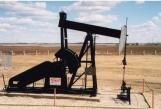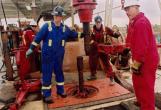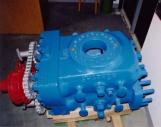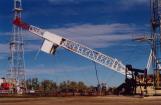1
To live or work in the oil patch, one needs to learn the language. Using definitions by Dan Claypool and images from the Canadian Petroleum Interpretive Centre, you will become familiar with some of the more commonly used terms.3
CREW LISTCATHEAD MAN- is responsible for spinning the pipe or lifitng heavy items by catline and cathead motion. Also services the motor drivers to the drawworks. Now known as the motorman.
DERRICK HAND- works up the derrick when pulling drill pipe out of the hole (tripping pipe). His job is to latch and unlatch the elevators and organize the pipe in the derrick. When not tripping, he is resonsible to ensure that the drilling mud is of the proper specifications.
DRILLER-The driller is the individual who runs the drawworks, which is the hoisting unit to pull and run pipe and provides power for the rotary table. He is the shift supervisor of the drilling crew. He has normally spent many years on a drilling rig gaining the knowledge to become a driller. There is one driller on each shift.
MUD MAN- He is responsible for setting up and maintaining a drilling mud program that is suitable for the particular drilling conditions expected to be encountered and to maintain well control while drilling.
ROUGHNECK- The roughneck (two to a crew) works on the drilling floor when tripping: pulling and running pipe, operating the pipe tongs and elevators. When not tripping he takes cutting samples and does general rig maintenance.
TOOLPUSHER- This individual has normally had a long career in the drilling business and is very experienced in all types of drilling business and is very experienced in all types of drilling situations. Acts as the rig manager, on call 24 hours a day and is the drilling company's representative on the drilling site. The term "tool pusher" came from cable tool rig days when he instructed the tool dresser on creating the drilling bit in a forge on site.
5
BARREL OF OIL- In the age of metric, the ever-popular "barrel" remains the world standard of oil measurement. For comparison sake, it converts to either 35 Imperial Gallons or 42 U.S. gallons. For those metrically inclined, one barrel equals 158.987 litres.BLOWOUT PREVENTER- (Pictured) More commonly known as a BOP, this piece of safety equipment consists of a set of rams in a high-pressure steel body, installed under the rig floor and flanged onto the top of the surface casing. When the rams are closed around the drill pipe, a well blowout- a potentially dangerous situation- is prevented.
6
Cable Tool on Display27 August 2003
Canadian Petroleum Interpretive Centre, Devon, Alberta, Canada

7
CABLE TOOL DERRICK-(pictured) Wooden derricks were used on the original cable tool rigs. All of the girts and beams were designed by engineers and produced by carpenters and saw mills so each piece of wood fitted exactly in its place in the derrick. The pieces were then cataloged and listed for sale by oilfield supply companies. Any time a piece of the derrick was damaged the supply store could replace that piece from stock. The well is drilled by raising and lowering a heavy bit and slowly pounding a hole into the ground.CATHEAD- A revolving spool placed on a shaft attached to the side of the drawworks to wind rope around for spinning in drill pipe, or to lift objects on the rig floor.
9
On February 13th, 1947, in front of invited guests of Imperial Oil, the media and the curious, the Leduc No. 1 well, with Vern Hunter as the toolpush, came into production.Leduc No. 1 signalled a change in Alberta's oil future. When just months ago, a major oil find in Alberta had seemed elusive, Leduc No. 1 promised more where that came from.
11
DRILL BITS- (pictured) The drill bits are attached to the bottom of the drill pipe and is activated by the rotation of the pipe. There are teeth on the rotating cones, and they are equipped with roller bearings which turn under the heavy weight on the drill pipe. Each cone has a different tool pattern which provides the chipping motion required to drill solid rock. Drilling mud is pumped down the drill pipe to cool and lubricate the bit and remove the cuttings and circulate them to surface.FISHING-This has nothing to do with drillers bagging a few trout for dinner from a nearby stream during time-off. Instead, when a drilling rig looses a string of pipe or piece of equipment down the drill hole, a specialized set of Fishing Tools may be run down the hole to recover the Fish.
13
GUSHER- is a well that has the potential to produce large commercial quantities of hydrocarbons.JACKNIFE RIG- (pictured) A steel framed rotary drilling derrick that is designed so it can be stood up and laid down in one piece. This design replaced the conventional derrick that had to be assembled and disassembled on site piece by piece.
14
Leduc No. 1 Provincial Historic Site1997
Canadian Petroleum Interpretive Centre, Devon, Alberta, Canada





